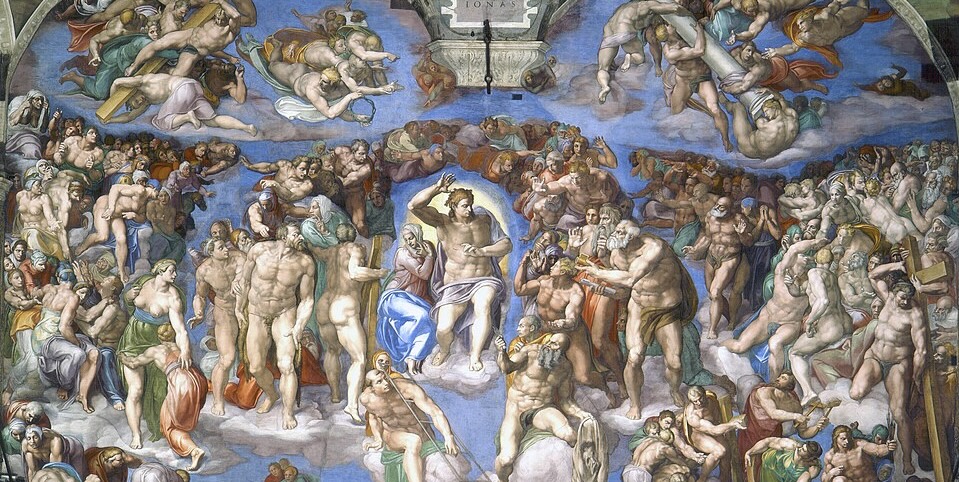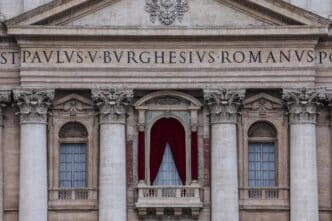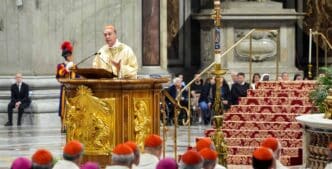When the cardinals of the Catholic Church vote for the next pope, they will do so in front of a 16th-century masterpiece: Michelangelo’s fresco of “The Last Judgment.” There’s a special significance behind this, according to Rome-based art historian Elizabeth Lev.
“At the end of the day, the reason was to create a backdrop of accountability,” Lev said of the painting. “And that backdrop of accountability is particularly evident in the moment of the conclave.”
Following the death of Pope Francis on April 21, 133 cardinal electors from around the world will gather in private to discern the next head of the Church. During this papal election or conclave, which begins May 7, these Church leaders will vote up to four times a day from the Sistine Chapel in Vatican City until a two-thirds majority is reached. Each cardinal will place his vote for the next pope — the 266th successor of St. Peter — into an urn in front of Michelangelo’s painting.
Lev spoke with Our Sunday Visitor about the meaning behind selecting a new pope in front of “The Last Judgment,” which was painted by Italian artist Michelangelo on the wall behind the chapel’s altar between 1536 and 1541. The fresco, which centers around the figure of Christ, depicts the moment before the verdict of God’s final judgment of all humanity, according to the Vatican Museums.
Painted at a crucial juncture
Michelangelo created it, Lev said, during a critical moment for the Church.
“The pontificate of (Pope) Clement VII had ended, (Pope) Paul III’s was beginning,” she said. “It was the moment of the Protestant Reformation.”
“Just as Michelangelo was about to put the scaffolding up on the wall, the pope receives a letter from Henry VIII that basically declares that he’ll be starting his own church,” she said of the former king of England, adding that the cardinal and nearly all of the bishops of England followed in this new direction.
She encouraged people to think about why Pope Clement VII, who commissioned the work, would have chosen this subject matter. Italian painter Pietro Perugino had already painted three scenes on the wall that the massive “Last Judgment” would cover: paintings of the Nativity, the finding of Moses in the reeds and the Assumption of the Virgin. The creation of “The Last Judgment,” Lev said, involved a great deal of destruction.
‘The eyes of God’
Often, Lev said, people want to know where they can find Michelangelo’s self-portrait in the painting, where to spot the cardinal that Michelangelo disliked or whether the image’s nude figures were covered up. She called these “distractions from what the painting is trying to say.”
“It’s shaped like the tablets of the Ten Commandments,” Lev described. “It leans slightly towards you and it shows this abundance of bodies that break away from the ground.”
“Each one of these bodies has to stand — in the words of St. John Paul II, who wrote a poem about this painting — they stand nude and transparent before the eyes of God,” Lev added, citing Pope St. John Paul II’s “Roman Triptych: Meditations.”
In a presentation of this poem in 2003, then-Cardinal Joseph Ratzinger remembered the conclaves that took place in 1978 and acknowledged the impact of Michelangelo’s fresco.
“I know well how we were exposed to those images in the hour of the important decisions,” he said, “how they challenged us and how they instilled in our souls the greatness of our responsibility.”
A message from the angels
Lev called it a painting that “makes you think about how your actions are so important.”
“The fact that the bodies are so prevalent, the fact that the bodies are so powerful, is a representation of those who have exercised heroic virtue to be able to cooperate in their salvation to reach heaven versus those who have used their bodies for bad actions,” she said.
She highlighted how a group of angels appears directly above the altar that stands in front of the fresco. Some of them are sounding trumpets, while the two in front hold books, with the smaller book to the left and the larger book to the right. These represent the Book of the Good Deeds and the Book of the Bad Deeds.
“Those angels, in typical paintings of the Last Judgment, are placed way, way, way up high,” she said. “But in this particular context, just as the cardinal puts his vote into the urn and he raises his eye, there are … angels blowing their horns, calling the dead back to life.”
“So you can really understand that people will be called to account,” Lev concluded. “What did you do? What didn’t you do? How have you acted? What has been your choice, the choices that you’ve made? Will those choices bring you to heaven or will those choices lead you to damnation?”







